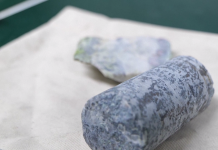
When the manned spacecraft Shenzhou-9 was launched in June 2012, six silk-printed photographic works traveled into space together with the three taikonauts onboard the craft. One of the six works is based on a photo Vista of Xiapu. The artwork depicts mudflats covered in sunshine in Xiapu County, Fujian Province.
Xiapu has a coastline of 510 km and about 70,000 hectares of shallow sea tidal flats. The terrain here is level and gentle, with clear seawater as well as fine, soft mud and sand. The ebb and flow of the tides create diverse gullies and other patterns on the tidal flats. Flats, transforming with the seasons, tides and light, offer mesmerizing and dreamlike vistas.
Xiapu’s beautiful coastal scenery attracts thousands of domestic and international photographers each year, all seeking to capture its stunning moments. Vista of Xiapu is just one of many capturing these wonderful moments.
A paradise for photographers
“It all started because of photography,” said Huang Kejin, Secretary of the Communist Party of China Sansha Township Committee, in a group interview. Zheng Dexiong, Chairman of the Xiapu County Photography Association, captured exceptionally beautiful photographs of Xiapu’s tidal flats, coastlines and other natural landscapes in the early 2000s, and his works have repeatedly won awards in major photography competitions, he added. As a result, numerous photographers were attracted to the county, sharing their own captivating images across different platforms, further drawing more people to Xiapu for photographic exploration and tourism. This cycle gradually elevated Xiapu’s scenery to national prominence.
To better serve a growing number of photographers, Xiapu in recent years has developed 71 dedicated photography spots and mapped out four professional photography routes, ensuring that visitors capture the most stunning moments, including sunrises, sunsets and tidal variations. Nowadays, the number of photography tourists visiting the county averages around 700,000 a year.
In the early 2000s, when Zheng’s photos first caught the eye of photography aficionados, the burgeoning photography tourism industry in Xiapu was hindered by poor accommodation, which discouraged visitors from staying long.
Seeking to solve this, Zheng pioneered the idea of opening homestays. His protégé, Chen Shuman, recognized this business opportunity and established a homestay named Shijianhai in Dongbi Village of Xiapu in 2017.
Today, it is a popular attraction with an occupancy rate of 85 percent, even on weekdays. Inspired by its success, local villagers rushed to renovate their homes, causing homestays to mushroom throughout Xiapu. Dongbi alone is now home to 62 homestays.
Endowed with a unique landscape where the mountains meet the sea, Xiapu is now home to a thriving cluster of over 600 homestays. This booming sector receives more than 1.3 million visitors annually, generating over 400 million yuan ($56 million) in turnover and creating nearly 20,000 local jobs.
Among these is the Dongli Homestay in Gutong Village. Lesser-known than Dongli, Gutong offers a more tranquil environment, perched halfway up a hill where guests can enjoy clear views of the sea from their rooms.
Lin Fangfang, the housekeeper and cook at Dongli Homestay, was entrusted by the owner—a relative of hers—to manage the inn. Before it opened in 2022, she took on odd jobs to get by, and her family relied mainly on her husband’s income from seaweed farming. Now, her life has improved significantly. She has a stable job with an annual income of over 100,000 yuan ($14,000). Even the homestay’s two cleaners earn 5,000 yuan ($700) a month. With eight rooms, the business brings in approximately 1 million yuan ($140,000) in annual revenue.
“Because of the charming scenery and our good service, a lot of guests tend to come back,” Lin told Beijing Review.
Most villagers in Xiapu once eked out a living through marine fishery. Now, many lease their properties to homestay developers, providing them with a steady monthly rental income. Others have begun operating seafood stalls to cater to the stream of tourists flocking to this photography paradise.
In the first seven months of this year, Xiapu received 8.74 million tourist visits, generating total tourism revenue of 9 billion yuan ($1.26 billion )—a year-on-year increase of 20 percent.

Catching waves
According to an official document released by the Fujian Provincial Government in early May, the local cultural and tourism sector is to be developed into a pillar industry of the province. By 2027, the value added of this industry is expected to reach 750 billion yuan ($100 billion). Meanwhile, different areas are encouraged to tap into their respective tourism resources, in terms of cultural heritage and natural scenery.
Pingtan Island, the fifth largest island in China, will be developed into an international tourism island, according to a plan approved by the State Council in 2016. Boasting 408 km of coastline, around 70 km of sandy beaches and 126 islands, Pingtan abounds in marine tourism attractions.
The island launched the No.22 International Yacht Marina in June 2024, featuring 49 berths and offering a variety of water-based entertainment, including sailing, yachting, artificial wave surfing, jet skiing, water go-karting and diving. Since being put into operation, the facility has received around 17,000 tourist visits, and the number of visits keeps growing, especially during the summer vacation.
Lu Yanlin, a young mother from Nanjing County of Fujian, discovered the marina’s attractions on Douyin (the Chinese version of TikTok) and brought her children to visit. As an experienced traveler, she found the fees for the water sports very reasonable and her children enjoyed nearly every activity. “I will definitely bring them back here again,” she said.
The marina’s main attraction, however, is its yachts. The berth holds 12 yachts, and shared excursions make yachting more accessible than the luxury activity it is often perceived to be. “For 10 people, a yacht rental costs 3,000 yuan ($420) per hour. It is quite affordable for most people, which encourages many to try it,” said Chen Ziliang, General Manager of Pingtan Travel and Transport Co. Ltd. Since opening, the marina has proven particularly popular with young tourists seeking group outings.
In recent years, Pingtan has shifted its primary industries from traditional seafood farming and shipping to new business models related to tourism like homestays and transportation services.
Chen Jingsheng, a 57-year-old fisherman from a nearby village, acquired his yacht captain certification last year and is now employed as a captain at the marina.
His past experience of battling rough seas while fishing makes yacht piloting easy. “Working at the marina offers a more relaxed and stable lifestyle than fishing and offers older fishermen a new choice,” said Chen Jingsheng in a group interview on August 20. Actually, even a lot of younger fishermen are opting to get their yacht captain’s license and transition from fishing and aquaculture industries to the yachting industry.
Meanwhile, Pingtan is moving up the industry chain by prioritizing yacht manufacturing. According to Chen Ziliang, his company has established a joint venture with Kha Shing Enterprises Co. Ltd. from the Taiwan region. Production is scheduled to begin in March 2026, and yachts made in Pingtan will then be sold nationwide and worldwide. At full capacity, the venture is expected to employ approximately 500 workers.
The cultural canvas
Fujian is rich in culture, from the Hakka earth buildings in Nanjing to Xunpu’s flowery headdresses and Zhangzhou’s hand puppet shows—all of which have become major local attractions.
Distinct from neighboring counties, Putian City takes pride in its exceptional academic legacy and ancient lychee trees. Historically, Putian produced 2,482 jinshi (holders of the highest imperial degree) and 21 zhuangyuan (imperial exam champions). Today, it is also the hometown of 15 members of the Chinese Academy of Engineering (CAE) and Chinese Academy of Sciences (CAS)—a record rare among Chinese cities.
Beida Village in Putian also embodies this blend of scholarly heritage and natural beauty. Accessible by ferry from downtown, the village is set where three rivers converge and is home to over 1,500 century-old lychee trees, a Ming Dynasty (1368-1644) bridge and a Mazu temple. Along the river, sculptures and steles commemorate the lives of Putian’s 21 zhuangyuan and 15 CAE and CAS members.
Its name, Beida, is also a homophone for prestigious Peking University. Here, a zhuangyuan-themed park offers an immersive experience: Walking through memorial gates symbolizing successive exam levels makes visitors feel like they’re passing the imperial examinations themselves.
Visitors, especially young students and parents with their children, are drawn to this place. They cherish the hopeful belief that “by visiting Beida, you may gain admission into Peking University.”
In the Northern Song Dynasty (960-1127), Xu Duo, a zhuangyuan from Putian, planted a lychee tree in today’s Licheng, which is already over 940 years old and still continues to produce juicy and sugary lychees every year.
“Putian was a cradle for zhuangyuan, as well as luscious lychees, so we extracted these two key elements and combined them together here, in Beida,” Zheng Zhizhi, a researcher of local culture in Putian, who contributed the idea of creating the zhuangyuan-themed park in Beida, told Beijing Review. Before the park was built in early 2025, people came to the village solely to get a taste of its lychees. Nowadays, they also come here to go on educational tours.
The increase in visitors has substantially boosted the collective income of Beida, which in 2024 rose by approximately 400,000 yuan ($56,000) compared to the previous year. In addition to selling lychees, the village’s 1,476 households can now earn income by operating riverside camps, food and beverage services, teahouses and other businesses.
“All this is just a start,” said Zheng Zhizhi. His team will dig deeper into the local culture and add more traditional elements to the zhuangyuan-themed park, so as to attract more visitors from far and wide. For the dozens of ancient villages in Putian, like Beida, the journey toward prosperity has only just begun. –The Daily Mail-Beijing Review News exchange item




